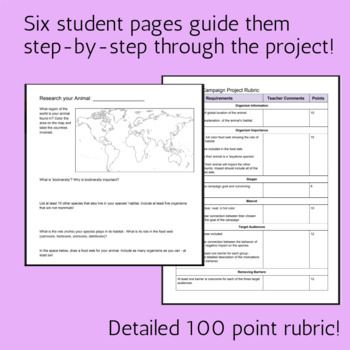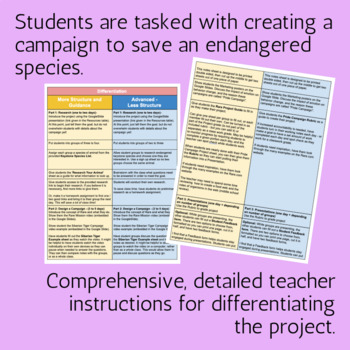Endangered Species Ecology Project | Human Impact on the Environment
- Google Drive™ folder

What educators are saying
Description
In this in-depth Endangered Species Project, students investigate the culture of a people group living near a chosen Endangered Species, and create a campaign to save that species. The project is a great end-of-year or end-of-unit assignment for Ecology.
Laws and regulations for protecting endangered species are needed, but do not always work if the community is not on board. But if a community has PRIDE in their native species, they will be motivated to save the species, and to protect the habitat it lives in.
The activity models RARE - an organization that goes into communities and works with people to educate and empower them to save their native endangered species. Click here to take a look at what they do, it is amazing!
The objective of this project is for groups of students to COLLABORATE and create a campaign that aims at changing the hearts and minds of the community around which an endangered species lives.
In order to do this, your students will have to research their given (or chosen) endangered species to learn about their habitat, what niche they fill in the food web of that area, and what specific human actions are threatening them.
But then they have to take their knowledge and do something with it! They will have to THINK CRITICALLY to CREATE a campaign that will touch the hearts and change the attitudes of the people who live around these endangered animals. They will learn a bit about psychology and how to change behavior through COMMUNICATION and taking the needs of local peoples into consideration.
Resource includes
- Comprehensive teaching guide - differentiated for students who need less structure, and for students who need more structure
- A Google Slide presentation used to introduce the project to your students (also editable!)
- List of eight endangered species that I have used in my class, along with a resource link as a starting point for your students
- Student Guide for researching their endangered animal
- Example of a Rare Project with question sheet to give inspiration and ideas
- Three page Project Guide to lead students through the different parts of the project
- A comprehensive 100 point rubric
- TWO versions of a Feedback Form for your students to fill out while they watch groups present
Students will...
- Research their species and its importance in the environment. They will create a food web to visualize their species' niche.
- Determine who to target in their species' community, and how to change their minds about the species (for example, how to get farmers to protect a top predator, rather than fear them; how to motivate store owners to stop selling wild game; how to empower the community to work against poachers, etc)
- Design a mascot for their species
- Plan a community event that will engage the people living near the species
- Create a poster with their mascot and slogan
- Put it all together in a presentation to show the class what they learned and created
This project is one of my favorite ways to incorporate GLOBAL AWARENESS into my curriculum. Each student group will research a unique endangered species living in a different area of the world. Students will have to get to know that part of the world, the people, and the culture so they can find out how that community is impacting that endangered species.
-------------------------------------------------------------------------------------------------------------
Check out the other Biology Resources available at Science of Curiosity
Doodle Notes!
- Biomolecules Doodle Notes
- Cell Membrane Transport Doodle Notes
- Enzymes Doodle Notes and Full Lesson Plans
More Biology resources from Science of Curiosity!
- Ecology Writing Prompts: 13 Google Slids with robust writing prompts. Use for Exit Tickets, Assessments, Review, Discussion!
- Biomolecules Review - Up and Moving speed date activity!
- Ecosystem Project - differentiated project based learning
- Hidden Life of the Cell video guide - an excellent 60 minute video putting you inside a living cell!
- Photosynthesis Online Activity Guided Notes - Gamify Photosynthesis!
- Evolution and Natural Selection Review activity
- FREE Instinctive Animal Behavior Speed Dating Review Activity
- Bacteria Dichotomous Key Activity - use QR codes to ‘infect’ students with an unknown species of bacteria. They use the Key to figure it out what they have!
- NO PREP Cladogram Activity: What Does T-Rex Taste Like? Student Guide to an Online Interactive
- Fifty Biology Writing Prompts! Increase Literacy in your science classroom. Great for Bell Ringers, class discussion, and assessments
**Stay Curious!**





